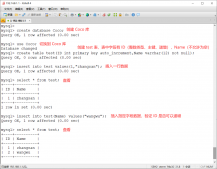概述
数据库中的数据直接呈现出来一般不是我们想要的,所以我们上两节演示了如何对数据进行过滤的方法。除了对数据进行过滤,
我们可能还需要对数据进行排序,比如想从列表中了解消费最高的项,就可能需要对金额字段做降序排序,想看年龄从小到大的分布情况,就可能需要对user表的age字段进行升序排序。
也可能需要对数据进行限制,比如我们需要对付款的1~10,11~20,21~30 名的用户分别赠予不同的礼品,这时候对数据的限制就很有用了。
备注:下面脚本中[]包含的表示可选,| 分隔符表示可选其一。
数据排序 order by
语法格式如下:
1、需要排序的字段跟在order by之后;
2、asc 和 desc表示排序的规则,asc:升序,desc:降序,默认为升序 asc;
3、排序可以指定多次字段,多字段排序之间用逗号隔开。
4、多字段排序中,越靠前优先级越高,下面中cname1优先排序,当cname1等值的时候,cname2开始排序,直至所有字段都排序完。
|
1
|
select cname from tname order by cname1 [asc|desc],cname2 [asc|desc]...; |
单个字段排序
举个例子,在销售额中通按照交易的订单进行金额额度降序的方式显示:
|
1
2
3
4
5
6
7
8
9
10
11
12
13
14
15
16
17
18
19
20
21
22
23
24
25
26
27
|
mysql> select * from t_order;+---------+---------+---------+-------+| orderid | account | amount | goods |+---------+---------+---------+-------+| 8 | brand | 52.2 | 2 || 9 | hen | 1752.02 | 7 || 10 | helyn | 88.5 | 4 || 11 | sol | 1007.9 | 11 || 12 | diny | 12 | 1 || 13 | weng | 52.2 | 5 || 14 | sally | 99.71 | 9 |+---------+---------+---------+-------+7 rows in setmysql> select * from t_order order by amount desc;+---------+---------+---------+-------+| orderid | account | amount | goods |+---------+---------+---------+-------+| 9 | hen | 1752.02 | 7 || 11 | sol | 1007.9 | 11 || 14 | sally | 99.71 | 9 || 10 | helyn | 88.5 | 4 || 8 | brand | 52.2 | 2 || 13 | weng | 52.2 | 5 || 12 | diny | 12 | 1 |+---------+---------+---------+-------+7 rows in set |
多个字段排序
多个字段排序用逗号隔开,优先级从左到右逐次递减,如下图,如果金额一致,则按照购买商品数量从多到少排序:
|
1
2
3
4
5
6
7
8
9
10
11
12
13
|
mysql> select * from t_order order by amount desc,goods desc;+---------+---------+---------+-------+| orderid | account | amount | goods |+---------+---------+---------+-------+| 9 | hen | 1752.02 | 7 || 11 | sol | 1007.9 | 11 || 14 | sally | 99.71 | 9 || 10 | helyn | 88.5 | 4 || 13 | weng | 52.2 | 5 || 8 | brand | 52.2 | 2 || 12 | diny | 12 | 1 |+---------+---------+---------+-------+7 rows in set |
按alias排序
按照别名排序或者做条件查询的目的都是为了简化代码,方便使用,别名可以是英文,也可以是中文:
|
1
2
3
4
5
6
7
8
9
10
11
12
13
14
|
mysql> select account as ac,amount as am,goods as gd from t_order order by am,gd desc;+-------+---------+----+| ac | am | gd |+-------+---------+----+| diny | 12 | 1 || weng | 52.2 | 5 || brand | 52.2 | 2 || helyn | 88.5 | 4 || sally | 99.71 | 9 || sol | 1007.9 | 11 || hen | 1752.02 | 7 |+-------+---------+----+7 rows in set |
字段排序中使用函数
下面使用了abs取绝对值函数,所以在 am字段降序排序中,-99.99 排在 99.71之上。
|
1
2
3
4
5
6
7
8
9
10
11
12
13
14
15
16
17
18
19
20
21
22
23
24
25
26
27
28
29
30
|
mysql> select * from t_order;+---------+---------+---------+-------+| orderid | account | amount | goods |+---------+---------+---------+-------+| 8 | brand | 52.2 | 2 || 9 | hen | 1752.02 | 7 || 10 | helyn | 88.5 | 4 || 11 | sol | 1007.9 | 11 || 12 | diny | 12 | 1 || 13 | weng | 52.2 | 5 || 14 | sally | 99.71 | 9 || 15 | brand1 | -99.99 | 5 |+---------+---------+---------+-------+8 rows in setmysql> select account as ac,amount as am,goods as gd from t_order order by abs(am) desc;+--------+---------+----+| ac | am | gd |+--------+---------+----+| hen | 1752.02 | 7 || sol | 1007.9 | 11 || brand1 | -99.99 | 5 || sally | 99.71 | 9 || helyn | 88.5 | 4 || brand | 52.2 | 2 || weng | 52.2 | 5 || diny | 12 | 1 |+--------+---------+----+8 rows in set |
与Where条件结合使用
order 在 where 条件之后,根据where已经过滤好的数据再进行排序。下面是过滤出购买金额>80 且 购买数量>5的数据,并且按照价格降序排序。
|
1
2
3
4
5
6
7
8
9
10
11
12
13
14
15
16
17
18
19
20
21
22
23
|
mysql> select * from t_order;+---------+---------+---------+-------+| orderid | account | amount | goods |+---------+---------+---------+-------+| 8 | brand | 52.2 | 2 || 9 | hen | 1752.02 | 7 || 10 | helyn | 88.5 | 4 || 11 | sol | 1007.9 | 11 || 12 | diny | 12 | 1 || 13 | weng | 52.2 | 5 || 14 | sally | 99.71 | 9 || 15 | brand1 | -99.99 | 5 |+---------+---------+---------+-------+8 rows in setmysql> select * from t_order where amount>80 and goods>5 order by amount desc;+---------+---------+---------+-------+| orderid | account | amount | goods |+---------+---------+---------+-------+| 9 | hen | 1752.02 | 7 || 11 | sol | 1007.9 | 11 || 14 | sally | 99.71 | 9 |+---------+---------+---------+-------+ |
数据limit
很多时候我们过滤出符合要求的数据之后,还需要得到这些数据中的某一个具体区间,比如对付款超过1000的用户的第1~10,11~20,21~30 名分别赠予不同的礼品,这时候就要使用limit操作了。
limit用来限制select查询返回的数据,常用于数据排行或者分页等情况。
语法格式如下:
|
1
|
select cname from tname limit [offset,] count; |
1、offset表示偏移量,就是指跳过的行数,可以省略不写,默认为0,表示跳过0行,如 limit 8 等同于 limit 0,8。
2、count:跳过偏移量offset之后开始取的数据行数,有count行。
3、limit中offset和count的值不能用表达式。
获取前n条记录
如下图,limit n 和 limit 0,n 是一致的:
|
1
2
3
4
5
6
7
8
9
10
11
12
13
14
15
16
17
18
19
20
21
22
23
24
25
26
27
28
29
30
31
32
33
|
mysql> select * from t_order;+---------+---------+---------+-------+| orderid | account | amount | goods |+---------+---------+---------+-------+| 8 | brand | 52.2 | 2 || 9 | hen | 1752.02 | 7 || 10 | helyn | 88.5 | 4 || 11 | sol | 1007.9 | 11 || 12 | diny | 12 | 1 || 13 | weng | 52.2 | 5 || 14 | sally | 99.71 | 9 || 15 | brand1 | -99.99 | 5 |+---------+---------+---------+-------+8 rows in setmysql> select * from t_order limit 2;+---------+---------+---------+-------+| orderid | account | amount | goods |+---------+---------+---------+-------+| 8 | brand | 52.2 | 2 || 9 | hen | 1752.02 | 7 |+---------+---------+---------+-------+2 rows in setmysql> select * from t_order limit 0,2;+---------+---------+---------+-------+| orderid | account | amount | goods |+---------+---------+---------+-------+| 8 | brand | 52.2 | 2 || 9 | hen | 1752.02 | 7 |+---------+---------+---------+-------+2 rows in set |
limit限制单条记录
这边我们获取支付金额中最大和最小的的一条记录。可以先使用 order 条件进行排序,然后limit 第1条记录即可:
|
1
2
3
4
5
6
7
8
9
10
11
12
13
14
15
16
17
18
19
20
21
22
23
24
25
26
27
28
29
30
|
mysql> select * from t_order;+---------+---------+---------+-------+| orderid | account | amount | goods |+---------+---------+---------+-------+| 8 | brand | 52.2 | 2 || 9 | hen | 1752.02 | 7 || 10 | helyn | 88.5 | 4 || 11 | sol | 1007.9 | 11 || 12 | diny | 12 | 1 || 13 | weng | 52.2 | 5 || 14 | sally | 99.71 | 9 || 15 | brand1 | -99.99 | 5 |+---------+---------+---------+-------+8 rows in setmysql> select * from t_order where amount>0 order by amount desc limit 1;+---------+---------+---------+-------+| orderid | account | amount | goods |+---------+---------+---------+-------+| 9 | hen | 1752.02 | 7 |+---------+---------+---------+-------+1 row in setmysql> select * from t_order where amount>0 order by amount asc limit 1;+---------+---------+--------+-------+| orderid | account | amount | goods |+---------+---------+--------+-------+| 12 | diny | 12 | 1 |+---------+---------+--------+-------+1 row in set |
以上就是MySQL 查询的排序、分页相关的详细内容,更多关于MySQL 查询的资料请关注服务器之家其它相关文章!
原文链接:https://www.cnblogs.com/wzh2010/p/13843024.html?utm_source=tuicool&utm_medium=referral

















